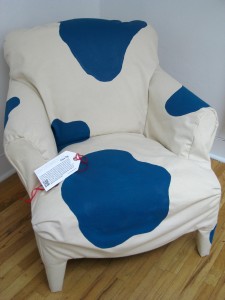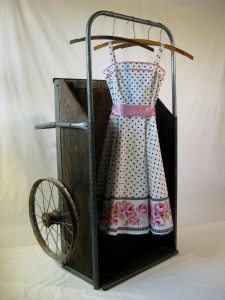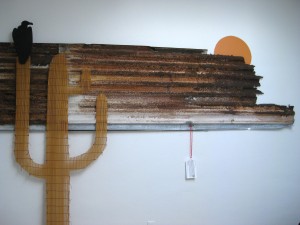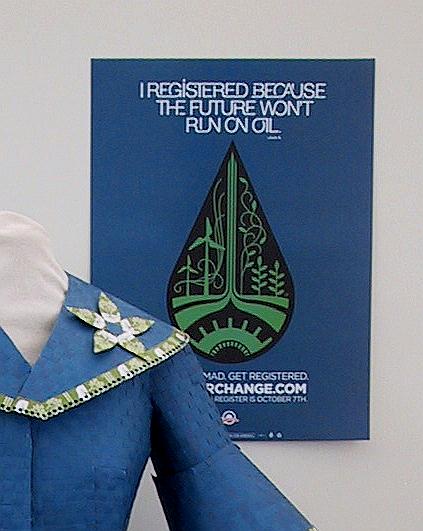Consumption: an installation exploring waste
 Thanks to a Centennial Project Space grant from New Mexico Arts that encourages artists to take risks with innovative space-specific installations, I challenged myself to create a piece very different from most of my work. It was new for me in two ways: 1.) It was a full collaboration, a first for me, with another artist, Nicole Morris; and 2.) instead of creating a recycled fashion we worked with waste in different ways.
Thanks to a Centennial Project Space grant from New Mexico Arts that encourages artists to take risks with innovative space-specific installations, I challenged myself to create a piece very different from most of my work. It was new for me in two ways: 1.) It was a full collaboration, a first for me, with another artist, Nicole Morris; and 2.) instead of creating a recycled fashion we worked with waste in different ways.
The project had two outcomes: to create an installation with reusable trash; and in the process of gathering the materials, provide a reuse study for the Santa Fe Solid Waste Management Agency. To learn more about the installation read the artists statement and a blog post about the project.
The exhibition was installed in the New Mexico Arts Centennial Project Space, located at 54 1/2 East San Francisco Street from April 13-May 11, 2012.
Press about Consumption:
Albuquerque Journal North, front page- April 8, 2012
New Mexican, Pasa Tiempo – April 20, 2012
View more photos from the installation and opening reception.
One of the intentions of the installation is education about some of the many effects of consumption. This was accomplished in numerous ways including “Environmental Price Tags” that are attached to the items in the installation. Below is a list of each piece in the show, the information on the “Price Tag”, and a link to more information.
RE-UPHOLSTERED CHAIR
 The treated wood in furniture (usually made from particleboard) is poisonous for people and the planet. These products often contain toxic substances that can off-gas into your home—including formaldehyde, a suspected carcinogen used in adhesives, paints, and varnishes. Furniture with foam-filled cushions poses another peril. Foam is commonly treated with fire-retardant chemicals called polybrominated diphenyl ethers, or PBDEs. Exposure to PBDEs, which are chemical cousins to the banned PCBs, is particularly harmful to fetuses and can cause brain and reproductive system disorders. Second hand furniture is no longer off-gassing these harmful chemicals.
The treated wood in furniture (usually made from particleboard) is poisonous for people and the planet. These products often contain toxic substances that can off-gas into your home—including formaldehyde, a suspected carcinogen used in adhesives, paints, and varnishes. Furniture with foam-filled cushions poses another peril. Foam is commonly treated with fire-retardant chemicals called polybrominated diphenyl ethers, or PBDEs. Exposure to PBDEs, which are chemical cousins to the banned PCBs, is particularly harmful to fetuses and can cause brain and reproductive system disorders. Second hand furniture is no longer off-gassing these harmful chemicals.
Source: World Watch Institute
More information
LEATHER SADDLE
 The leather industry is highly polluting and has adverse impacts on the environment. In 2005 the global production of leather was almost 29 billion yards squared. Waste water from tanneries have high contents of potentially toxic metal salts and chromium metal ion. The presence of sulphide, ammonia and other volitle organic compounds are also associated with tanning activities. Skin trimmings, Keratin wastes, fleshing wastes, chrome shaving wastes and buffing wastes are solid wastes generated in the leather industries and are hazardous to the environment if not disposed of or treated properly.
The leather industry is highly polluting and has adverse impacts on the environment. In 2005 the global production of leather was almost 29 billion yards squared. Waste water from tanneries have high contents of potentially toxic metal salts and chromium metal ion. The presence of sulphide, ammonia and other volitle organic compounds are also associated with tanning activities. Skin trimmings, Keratin wastes, fleshing wastes, chrome shaving wastes and buffing wastes are solid wastes generated in the leather industries and are hazardous to the environment if not disposed of or treated properly.
Source: Journal of Scientific & Industrial Research
More information
LITE BRITE® TOY
 Lead, cadmium and toxic additives to plastic have been used over the years to make toys and are dangerous for children especially when put in their mouths. Lead, found in paint and toy jewelry, can cause behavioral problems, learning disabilities, seizures and death. Cadmium used to make metal toy jewelry, may cause kidney disease and developmental effects. Phthalates are used to make PVC plastic soft and flexible for items ranging from baby teethers to Barbie dolls. Phthalates can cause developmental abnormalities, interfere with hormone systems, and have negative effects on the male reproductive system. Reusing toys can be a good idea, but assure that they are lead, cadmium and PVC free.
Lead, cadmium and toxic additives to plastic have been used over the years to make toys and are dangerous for children especially when put in their mouths. Lead, found in paint and toy jewelry, can cause behavioral problems, learning disabilities, seizures and death. Cadmium used to make metal toy jewelry, may cause kidney disease and developmental effects. Phthalates are used to make PVC plastic soft and flexible for items ranging from baby teethers to Barbie dolls. Phthalates can cause developmental abnormalities, interfere with hormone systems, and have negative effects on the male reproductive system. Reusing toys can be a good idea, but assure that they are lead, cadmium and PVC free.
Source: Environmental Protection Agency
More information
BED
 Mattresses and landfills do not mix well. Mattresses take up a lot of space – up to 23 cubic feet each, multiply this by the more than 300 mattresses that are tossed daily. The good news is that 90 percent of the material in mattresses can be recycled. Metal springs are melted down and sold to steel companies, the cotton and foam are bought by companies who use it for carpet bagging or insulation and the wood is commonly sold to wood chippers or burnt for fuel. (We could not take any of the mattresses we saw thrown away due to health laws.)
Mattresses and landfills do not mix well. Mattresses take up a lot of space – up to 23 cubic feet each, multiply this by the more than 300 mattresses that are tossed daily. The good news is that 90 percent of the material in mattresses can be recycled. Metal springs are melted down and sold to steel companies, the cotton and foam are bought by companies who use it for carpet bagging or insulation and the wood is commonly sold to wood chippers or burnt for fuel. (We could not take any of the mattresses we saw thrown away due to health laws.)
Source: Earth 911
More information
LAMP
 It will take approximately 1 million years for the glass in this lamp to break down, 100 years for the metal base and parts, 50-80 years for the plastic parts, and 2-4 weeks for the paper and wood in the lamp shade. Most things that we casually throw away will sit in the landfill and outlive us, our children, grandchildren and great, great grandchildren! Is this the legacy that YOU want to leave behind? Reduce your waste, reuse and recycle everything you can and buy from thrift stores!
It will take approximately 1 million years for the glass in this lamp to break down, 100 years for the metal base and parts, 50-80 years for the plastic parts, and 2-4 weeks for the paper and wood in the lamp shade. Most things that we casually throw away will sit in the landfill and outlive us, our children, grandchildren and great, great grandchildren! Is this the legacy that YOU want to leave behind? Reduce your waste, reuse and recycle everything you can and buy from thrift stores!
Source: Penn State University and the Ocean Conservancy
More information
BOOK
 To create this little book:
To create this little book:
- The materials used were paper, inks, and binder glues;
- Energy was used to manufacture the books and power the delivery vehicles;
- Emissions were released into the air and water during manufacturing and transportation; and
- Waste was created in the whole process.
When we throw something in the trash, not only are we wasting the item itself, but also all the resources used in making it and the time and energy spent to mitigate the damage of the pollution left behind. Don’t throw anything away that still has some life left in it! But if you must, books can be recycled.
Source: Center for Sustainable Systems
More information
REPAINTED KITCHENETTE
 Approximately 10 percent of all paint purchased in the United States is not used (e.g., leftover from a paint project). This amounts to about 64 million gallons annually. Leftover paint and can have a negative impact on the environment if not disposed of properly. For example, chemicals from paint discarded at a landfill can accumulate and leach into the surrounding soil and groundwater. Although lead has been banned in household paint since 1978, some older buildings still have lead which creates unhealthy living environments. Both oil based and latex paints can be reused and or recycled.
Approximately 10 percent of all paint purchased in the United States is not used (e.g., leftover from a paint project). This amounts to about 64 million gallons annually. Leftover paint and can have a negative impact on the environment if not disposed of properly. For example, chemicals from paint discarded at a landfill can accumulate and leach into the surrounding soil and groundwater. Although lead has been banned in household paint since 1978, some older buildings still have lead which creates unhealthy living environments. Both oil based and latex paints can be reused and or recycled.
Source: Environmental Protection Agency
More information
WOOD ROCKING HORSE
 Approximately 6% (12.0 million metric tons) of all waste generated is wood and less than 10% of this wood was recovered for recycling or composting, and 22% was combusted (nearly all for energy recovery); the remaining 8.2 million metric tons was discarded. Some of this waste comes from households and much of it comes from construction and demolition activities. Recycled wood is made primarily into landscaping mulch and waste wood for fuel. Chipped or shredded wood is also used as a composting bulk agent, sewage sludge bulking medium, and animal bedding. Recovered wood can also be used to make medium density fiberboard and particleboard. Also, the demolition industry salvages wood through deconstruction which recovers and reuses wood for flooring, doors, windows, and other applications.
Approximately 6% (12.0 million metric tons) of all waste generated is wood and less than 10% of this wood was recovered for recycling or composting, and 22% was combusted (nearly all for energy recovery); the remaining 8.2 million metric tons was discarded. Some of this waste comes from households and much of it comes from construction and demolition activities. Recycled wood is made primarily into landscaping mulch and waste wood for fuel. Chipped or shredded wood is also used as a composting bulk agent, sewage sludge bulking medium, and animal bedding. Recovered wood can also be used to make medium density fiberboard and particleboard. Also, the demolition industry salvages wood through deconstruction which recovers and reuses wood for flooring, doors, windows, and other applications.
Source: USDA Forest Service
More information
SUN DRESS
 The environmental impact of our clothes? Americans throw away more than 68 pounds of clothing and textiles per person per year; this represents about 5% of the municipal solid waste stream. And material production matters too:
The environmental impact of our clothes? Americans throw away more than 68 pounds of clothing and textiles per person per year; this represents about 5% of the municipal solid waste stream. And material production matters too:
- Polyester, the most common manufactured fiber, is made from petroleum and emits volatile organic compounds (VOCs) and acid gases into the air.
- The manufacturing of nylon emits nitrous oxide – its carbon footprint is 310 times that of carbon dioxide.
- Rayon, derived from the wood pulp of water hungry eucalyptus trees, often relies on clearing old growth forests.
- Cotton is the most pesticide-dependent crop in the world. One t-shirt equals 1/3rd of a pound of pesticides.
Source: Earth911 and Environmental Protection Agency
More information
COWBOY BOOTS
 Life cycle assessment, or LCA, is a “cradle-to-grave” approach for assessing industrial systems. “Cradle-to-grave” begins with the raw materials used to create the product and ends when all materials are returned to the earth. LCA evaluates all stages of a product’s life showing interdependence, often including impacts more traditional analyses don’t considered such as: raw material extraction, material transportation, ultimate product disposal, etc. Since LCA includes the environment impacts throughout the product life cycle, it provides a more accurate picture of the true environmental trade-offs in product and process selection.
Life cycle assessment, or LCA, is a “cradle-to-grave” approach for assessing industrial systems. “Cradle-to-grave” begins with the raw materials used to create the product and ends when all materials are returned to the earth. LCA evaluates all stages of a product’s life showing interdependence, often including impacts more traditional analyses don’t considered such as: raw material extraction, material transportation, ultimate product disposal, etc. Since LCA includes the environment impacts throughout the product life cycle, it provides a more accurate picture of the true environmental trade-offs in product and process selection.
Source: Environmental Protection Agency
Sample LCA on shoes
CORRUGATED STEEL ON WALL
 Steel and iron represent 6.8 percent of the municipal solid waste stream in the United States. The steel industry has been recycling steel scrap for more than 150 years, and steel products now contain anywhere from 25% to 100% recycled content. It’s less expensive and reduces energy consumption to recycle steel rather than to mine virgin ore for manufacturing new steel; this also reduces the amount of greenhouse gases released during processing. Deconstruction is one form of recycling that is an innovative approach for reclaiming many building materials including steel. In contrast to demolition where buildings are knocked down and materials are eitherland filled or recycled, deconstruction involves carefullytaking apart portions of buildings or removing their contentsfor reuse.
Steel and iron represent 6.8 percent of the municipal solid waste stream in the United States. The steel industry has been recycling steel scrap for more than 150 years, and steel products now contain anywhere from 25% to 100% recycled content. It’s less expensive and reduces energy consumption to recycle steel rather than to mine virgin ore for manufacturing new steel; this also reduces the amount of greenhouse gases released during processing. Deconstruction is one form of recycling that is an innovative approach for reclaiming many building materials including steel. In contrast to demolition where buildings are knocked down and materials are eitherland filled or recycled, deconstruction involves carefullytaking apart portions of buildings or removing their contentsfor reuse.
Source: Environmental Protection Agency
More information
RE-PURPOSED WHEELBARROW MADE INTO A CLOSET
So much of consuming is about filling a void we’re lead to believe we have. So much on the market today is about beautiful, sleek, eye-catching design. Why not fill that void with our own creativity, instead of someone else’s, by re-purposing or by trading the things we no longer want for things we may want to re-purpose? Re-purposing can be a simple as applying a new coat of paint to an old object giving it a new life or new look. Or you can step out of the box and really push your boundaries…what is a completely new purpose for some item that you thought was trash?
More information
PILLOW THAT WAS NATURALLY FUMIGATED
 We were asked to fumigate all of the upholstered items in this exhibition. Fumigation poisons unwanted insects in furniture as well as buildings, soil, grain, and produce. It uses toxic chemicals that kill the insects, but are also often harmful to humans, animals and the environment. Looking for a non-toxic fumigation option, we contracted our local Santa Fe County Extension Office. They suggested the system that the New Mexico Forestry Division recommends for killing bark beetles—solarization! The method involves sealing the contaminated item (in their case piles of infested wood, in ours the chair and pillows in this exhibition) in clear plastic and putting it in the sun for 3-4 weeks. The heat in the plastic kills the bugs and their eggs. With a little bit of research you can usually find ways to avoid using toxic chemicals!
We were asked to fumigate all of the upholstered items in this exhibition. Fumigation poisons unwanted insects in furniture as well as buildings, soil, grain, and produce. It uses toxic chemicals that kill the insects, but are also often harmful to humans, animals and the environment. Looking for a non-toxic fumigation option, we contracted our local Santa Fe County Extension Office. They suggested the system that the New Mexico Forestry Division recommends for killing bark beetles—solarization! The method involves sealing the contaminated item (in their case piles of infested wood, in ours the chair and pillows in this exhibition) in clear plastic and putting it in the sun for 3-4 weeks. The heat in the plastic kills the bugs and their eggs. With a little bit of research you can usually find ways to avoid using toxic chemicals!
Source: New Mexico Forestry Division
More information
RUG
 This rug represents a potentially more eco-friendly way to warm-up your home then wall-to-wall carpets. Health and environmental concerns associated with carpet include indoor air quality, chemical emissions from manufacturing and disposal operations, and solid waste impacts. A variety of volatile organic compounds (VOCs) can be emitted from carpet materials, although VOC emissions from new carpet typically fall to very low levels within 48 to 72 hours after installation when accompanied by good ventilation. Over four billion pounds of carpet enter the solid waste stream in the U.S. every year. Furthermore, the variety of materials present in carpet makes it difficult to recycle, although new efforts are underway to increase recycling opportunities.
This rug represents a potentially more eco-friendly way to warm-up your home then wall-to-wall carpets. Health and environmental concerns associated with carpet include indoor air quality, chemical emissions from manufacturing and disposal operations, and solid waste impacts. A variety of volatile organic compounds (VOCs) can be emitted from carpet materials, although VOC emissions from new carpet typically fall to very low levels within 48 to 72 hours after installation when accompanied by good ventilation. Over four billion pounds of carpet enter the solid waste stream in the U.S. every year. Furthermore, the variety of materials present in carpet makes it difficult to recycle, although new efforts are underway to increase recycling opportunities.
Source: Environmental Protection Agency
More information








































